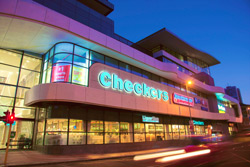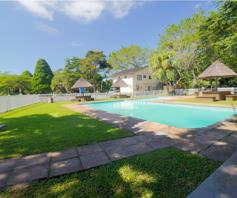Sea Point, is seeing massive urban regeneration with The Point, a R300 million redesign and rebuild of the former Galleria shopping centre in Regent Road, leading the “renaissance of the idiosyncratic Cape Town seaside suburb that seems about to come full circle”.
 Bought by the Berman Brothers for R52 million, the gloomy Galleria has become a light and airy nine-storey shopping and lifestyle centre appealing to all ages and incomes.
Bought by the Berman Brothers for R52 million, the gloomy Galleria has become a light and airy nine-storey shopping and lifestyle centre appealing to all ages and incomes.This is according to developers, Saul and Paul Berman, who say it is in the final stages of completion and already mostly let. The Point is a transformation of the 1984 Galleria building, which was anchored by a Checkers store and became the retail hub for residents living on the south-west end of Sea Point’s residential and restaurant strip.
Bought by the Berman Brothers for R52 million, the gloomy Galleria has become a light and airy nine-storey shopping and lifestyle centre appealing to all ages and incomes. The transformation has been in the hands of Louis Karol Architects, under the supervision of design partner Robert Silke.
The Point's tenants range from the completely redesigned Checkers, which has the biggest Kosher market in the Southern hemisphere, to Knead, the artisanal bakery and café, which Silke calls "the throbbing heart of Sea Point”.
There is also a Sportsman's Warehouse, BUC SWEAT Gym, Pick n Pay Clothing, and Dischem. Smaller tenants include NV80, an upmarket bar and grill by the Gonçalves brothers of Pigalle Restaurant Group; Lorna Jane, a popular Australian active wear brand and Banks’ Kitchen Boutique. Above the retail shops are health and lifestyle specialists such as beauty therapists, cosmetic surgeons and chiropractors, as well as offices. There are 21 office tenants, 24 retail stores and 10 health and wellness practices.
 The Point's tenants range from the completely redesigned Checkers, which has the biggest Kosher market in the Southern hemisphere, to Knead, the artisanal bakery and café, which Silke calls "the throbbing heart of Sea Point”.
The Point's tenants range from the completely redesigned Checkers, which has the biggest Kosher market in the Southern hemisphere, to Knead, the artisanal bakery and café, which Silke calls "the throbbing heart of Sea Point”.Chosen to design what the Berman Brothers hope will become a flagship for the new Sea Point, Louis Karol Architects is synonymous with the development of latter-day Cape Town. The firm was most recently responsible for designing the new Blue Route Shopping Centre and the original and subsequent Victoria Wharf, as well as Portside, the first skyscraper built in a South African CBD since 1993 (in a joint venture with dhk Architects).
"We needed architects who could realise a radical and modern design, and could also understand both the commercial and the business side of things. Louis Karol and Robert Silke are most capable of both,” says Saul Berman.
The brothers see Sea Point doing a 360° from the beach playground of the ‘70s and ‘80s via its lost years as a retail wasteland in the ‘90s and early 2000s, to the present day. The dream is of a High Street once again alive with restaurants both simple and chic, coffee bars, salons and shops - the urban heart of the Atlantic seaside on a major, sustainable comeback.
"Sea Point is Hillbrow's alternative reality," says Robert Silke, drawing a comparison with Johannesburg’s former vibrant inner city suburb that degenerated into a slum.
Silke, who grew up in Sea Point in the ‘80s, remembers the days when its Main Road had pharmacies on every block, toy shops in abundance and the air smelled of soap and perfume.
Then, at Sea Point's commercial pinnacle, came the development of the V&A Waterfront. Locals and tourists flocked to the Waterfront, leaving Sea Point's restaurants and shops empty. Eventually they collapsed. Main Road became Third World, and crime crept in.
What makes Sea Point capable of reinventing itself while Hillbrow seems likely to continue to wallow? "There are many differences between the two,” says Silke. “In Sea Point, there has always been less fear, and many of the original property owners did not sell up. With its large satellite population of domestic workers, Sea Point attracted a broad variety of South Africans first as apartheid and Group Areas Acts collapsed, and later on, foreigners from other African countries were attracted to the suburb.
 As for the future of retail/commercial development, Saul Berman believes it's in boutique shopping centres like The Point, not in massive sprawling malls.
As for the future of retail/commercial development, Saul Berman believes it's in boutique shopping centres like The Point, not in massive sprawling malls.“Cape Town is an older city with a better reputation for racial harmony and there were enough property owners who realised that Sea Point becoming more mixed was not a bad thing. Ultimately, it was Sea Point's Third World nature and natural integration that saved it."
Over the last several years, lower rents have attracted a bevy of new businesses, particularly restaurants. Like La Bohème and La Brixa, sister restaurants started by an ex-Caveau wine expert, modern French restaurant La Mouette and Andy's Sushi Bar, launched by a former Willoughby's chef. There's also a branch of Nü Health Food Cafe along with many new Chinese restaurants and markets. "It's still very affordable to start a restaurant in Sea Point," says Silke.
"Sea Point's renaissance is not to be confused with gentrification, which is the shift towards wealthier residences and businesses that results in the exclusion of lower income groups," says Silke. “The current renaissance means sustainable and genuine regeneration, not just a temporary boom. A great deal of the credit must go to the Police, who have dealt well with crime, and the City of Cape Town, for rolling out the successful MyCiti bus system.”
“And then there are those like the Berman Brothers, Sea Point's visionary players, determined to champion it into a new age.”
Saul and Paul Berman are self-made magnates in the construction industry. They grew up in Sea Point and never left, and have never stopped believing in it.
Twenty-five years ago, Saul started his business, and was joined by brother Paul five years later. Over time, they have bought seven major properties in Sea Point, all with the aim of improving the area, one project at a time.
The old Checkers Galleria was typical of the 1980s. It was designed for efficient flow of trolleys and delivery trucks, with little regard for people, other than to keep their focus on goods for sale rather than the outside world. Blank and windowless exterior walls were a barrier between customers and street life, and while Checkers always worked, the centre itself collapsed, says Silke.
"When you block out the windows, you kill the street, and dead streets are like open wounds, destroying city life," he says.
The new centre is one of the tallest buildings in Sea Point. It was a colossal building project, with mining equipment brought in for the additional basement required for the foundation and increased parking. According to Silke, this was the first building project in Cape Town to be excavated while tenants were still trading – Checkers was open as usual while a fourth basement was blasted underneath. Now there are 480 parking bays underneath what Berman calls "Sea Point's first true shopping centre".
With the brief from the Bermans to open the building to the streets, its walls are glass and modern, yet its shape was inspired by old Sea Point style moderne – late art deco from the 1930s to 1950s. Unlike its predecessor, its cafés spill out onto the sidewalk and it has multiple entrances and exits. "It is a reaction against how impenetrable the building was," says Silke."Yet while it is open, its views are not panoramic, they are gritty and urban. This is no fantasy, it's a vision of a confident, new and functional world. It is intended to celebrate the now, and is totally tuned to what the area needs," he says.
As for its developers, they are 100% committed to Sea Point, and always have been. "We knew that if we built up Sea Point, the values would increase," says Saul Berman. "If we don't rejuvenate the area, people won't want to live here. That's why we invested so heavily in The Point's externals, as well as its interiors. Now it's a place where people are coming to hang out with their neighbours."
"The Point has become one of those special parts of the city where friends meet, where boys meet girls and where chance encounters can happen," adds Silke.
"Sea Point might have been one of South Africa's first urban casualties," he says. "But now it's one of the first urban successes."
As for the future of retail/commercial development, Saul Berman believes it's in boutique shopping centres like The Point, not in massive sprawling malls. As for Sea Point, he'd take things a few steps further: in 10 years time, he'd like to see a significant portion of Main Road designated for pedestrians only, with access to underground parking from side streets, further revitalising the ‘High Street’.








